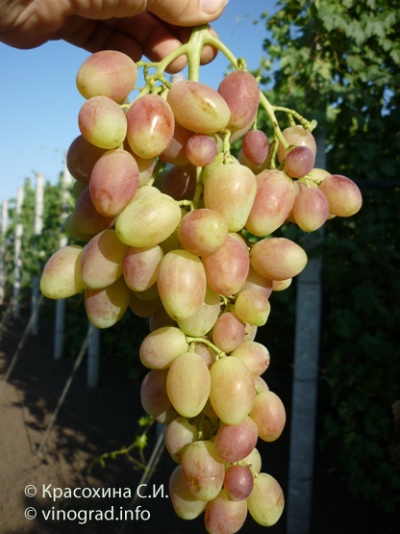
- Authors: Krainov Viktor Nikolaevich
- Appointment: dining room
- Berry color: white-pink
- Taste: harmonious
- Ripening period: early
- Bunch weight, g: 687
- Flower type: bisexual
- Peeling: there is a tendency
- Density of the bunch: loose and medium loose
- Skin: medium
Among gardeners, grapes with an early ripening period are very popular. The Angelica variety belongs to just such. In this article, we will consider its features, agrotechnical aspects, and also indicate frost resistance, diseases and pests.
Breeding history
Angelica grapes are already known to many gardeners, but few people know that the original name of the hybrid was Xenia. Sometimes the variety can be found under this name. The hybrid was crossed by an amateur breeder VN Krainov. The varieties Talisman and Luchisty raisins were chosen as parents. So in the city of Novocherkassk, a new table type of Ksenia grape was obtained, and in 2006 it was renamed.
Description
The Angelica grape is a representative of early maturing varieties. The bushes of the culture are strong, grow well, the vine grows 2/3 of its original length per season. The color of the branches is light brown.
The leaves are large, large, green in color, have three lobes and a characteristic section, there are notches along the edging.
The grape variety is prone to strong overload of the bushes, so you need to keep track of how many bunches are formed on one bush, there should be no more than three. Berries are prone to peas due to strong overload, because they simply lack nutrients.
Ripening period
Flowering begins in May, and the harvest can be harvested by mid-August. On average, the growing season is 4-4.5 months.
Bunches
Bunches of grapes are large, cylindrical in shape, oblong. Looseness prevails in the brushes. By weight, one bunch pulls out by 500-700 g. There have been cases when, under favorable conditions, good feeding and care, one bunch pulled out by 1.5 kg.
Berries
The berries are large, elongated, the tip is pointed. The fruit is 3.2 cm long and 2.3 cm wide.The average weight is 9.2 g.
The color of the berries is white-pink. The pulp is juicy, fleshy and crispy, medium in density. Although the skin is thin, it is still felt. Seeds are practically absent.
Taste
Angelica grapes have a pleasant, sweet and aromatic taste. The amount of sugar is 15-20%, but the acidity is 8 g / dm3. Indicators may vary depending on the weather conditions of the growing region.
Yield
The hybrid has high yields. From one bush is removed from 8 to 10 kg.


Growing features
When growing Angelica grapes, it is necessary to follow the schedule of watering and dressing. Timely spraying against pests. And also to carry out the correct pruning of vines.
For planting seedlings, the southern part of the site is chosen. The soil should not be swampy or have underground water underground. If you are not sure of this, then it is best to think over drainage or create an artificial mound.
The trellis system is always thought out in advance so that when the seedlings are planted, they are already installed. This is necessary because the vine grows very quickly and must be tied up in a timely manner.
After planting the seedlings, if the land has been fertilized with high quality, the bushes do not need additional feeding next year. Only fruit-bearing vines should be fed.
Landing
The area for the vineyard should be extensive so that the bushes grow harmoniously without interfering with each other. The distance between bushes in a row should be 1.5-2 m, and between rows 2-2.5 m.
The holes are dug to a depth of 0.8 m, and 0.5-0.8 m in diameter. Drainage is laid out on the bottom: broken brick or pebbles. Then it is covered with a fertile layer of earth. A seedling is planted, covered with earth. It is necessary to spill the seedling abundantly with water. Mulch can be laid around the bush to retain moisture for longer.

Pollination
Flowers in a hybrid of both sexes, so additional pollination is not required. Angelica grapes are sometimes used to pollinate other grape varieties where only female flowers are present.
Pruning
Pruning is carried out as needed to remove excess shoots, diseased vines and those that have broken off.
In summer, the leaves that grow below and those that close the bunches from sunlight are removed.



Frost resistance and the need for shelter
The frost resistance of the variety is -25 degrees. This allows in the southern regions not to cover the bushes and even not to remove them from the trellises. But in more northern regions, where there are sharp temperature changes, it is best to cover the bushes in order to protect the vine from icing.

Diseases and pests
Angelica grapes are resistant to a number of diseases. But the preventive work is still worth carrying out. It is best to choose drugs of external influence, they are safe and will not affect the harvest in any way.
Wasps and bees are not afraid of grapes.

If a grape is exposed to any disease or insect, this always affects its appearance.
Storage
The berries are stored in a dry and cool room at a temperature not higher than +2 degrees for 1-2 months.











































































